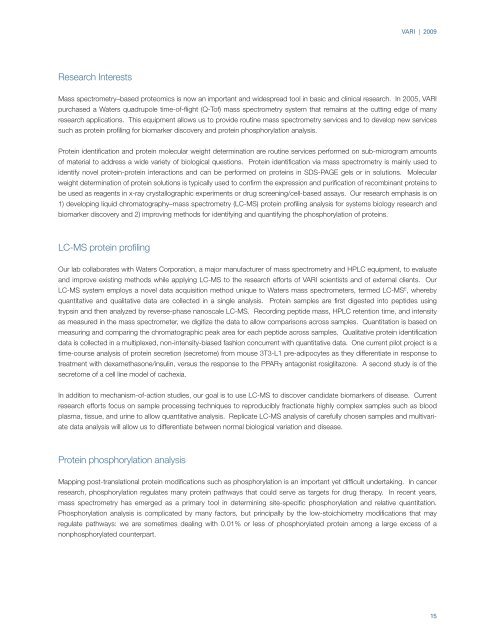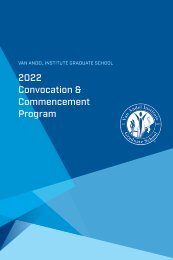2009 Scientific Report
Create successful ePaper yourself
Turn your PDF publications into a flip-book with our unique Google optimized e-Paper software.
VARI | <strong>2009</strong><br />
Research Interests<br />
Mass spectrometry–based proteomics is now an important and widespread tool in basic and clinical research. In 2005, VARI<br />
purchased a Waters quadrupole time-of-flight (Q-Tof) mass spectrometry system that remains at the cutting edge of many<br />
research applications. This equipment allows us to provide routine mass spectrometry services and to develop new services<br />
such as protein profiling for biomarker discovery and protein phosphorylation analysis.<br />
Protein identification and protein molecular weight determination are routine services performed on sub-microgram amounts<br />
of material to address a wide variety of biological questions. Protein identification via mass spectrometry is mainly used to<br />
identify novel protein-protein interactions and can be performed on proteins in SDS-PAGE gels or in solutions. Molecular<br />
weight determination of protein solutions is typically used to confirm the expression and purification of recombinant proteins to<br />
be used as reagents in x-ray crystallographic experiments or drug screening/cell-based assays. Our research emphasis is on<br />
1) developing liquid chromatography–mass spectrometry (LC-MS) protein profiling analysis for systems biology research and<br />
biomarker discovery and 2) improving methods for identifying and quantifying the phosphorylation of proteins.<br />
LC-MS protein profiling<br />
Our lab collaborates with Waters Corporation, a major manufacturer of mass spectrometry and HPLC equipment, to evaluate<br />
and improve existing methods while applying LC-MS to the research efforts of VARI scientists and of external clients. Our<br />
LC-MS system employs a novel data acquisition method unique to Waters mass spectrometers, termed LC-MS E , whereby<br />
quantitative and qualitative data are collected in a single analysis. Protein samples are first digested into peptides using<br />
trypsin and then analyzed by reverse-phase nanoscale LC-MS. Recording peptide mass, HPLC retention time, and intensity<br />
as measured in the mass spectrometer, we digitize the data to allow comparisons across samples. Quantitation is based on<br />
measuring and comparing the chromatographic peak area for each peptide across samples. Qualitative protein identification<br />
data is collected in a multiplexed, non-intensity-biased fashion concurrent with quantitative data. One current pilot project is a<br />
time-course analysis of protein secretion (secretome) from mouse 3T3-L1 pre-adipocytes as they differentiate in response to<br />
treatment with dexamethasone/insulin, versus the response to the PPARg antagonist rosiglitazone. A second study is of the<br />
secretome of a cell line model of cachexia.<br />
In addition to mechanism-of-action studies, our goal is to use LC-MS to discover candidate biomarkers of disease. Current<br />
research efforts focus on sample processing techniques to reproducibly fractionate highly complex samples such as blood<br />
plasma, tissue, and urine to allow quantitative analysis. Replicate LC-MS analysis of carefully chosen samples and multivariate<br />
data analysis will allow us to differentiate between normal biological variation and disease.<br />
Protein phosphorylation analysis<br />
Mapping post-translational protein modifications such as phosphorylation is an important yet difficult undertaking. In cancer<br />
research, phosphorylation regulates many protein pathways that could serve as targets for drug therapy. In recent years,<br />
mass spectrometry has emerged as a primary tool in determining site-specific phosphorylation and relative quantitation.<br />
Phosphorylation analysis is complicated by many factors, but principally by the low-stoichiometry modifications that may<br />
regulate pathways: we are sometimes dealing with 0.01% or less of phosphorylated protein among a large excess of a<br />
nonphosphorylated counterpart.<br />
15

















